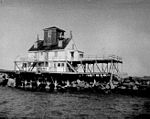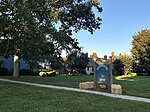De Vries Palisade
Archaeological sites on the National Register of Historic Places in DelawareBuildings and structures in Lewes, DelawareDelaware Registered Historic Place stubsGeography of Sussex County, DelawareNational Register of Historic Places in Sussex County, Delaware ... and 1 more
Use mdy dates from August 2023

De Vries Palisade, also known as DeVries Palisade of 1631, is an archaeological site located at Lewes, Sussex County, Delaware. It is the site of the Zwaanendael Colony, the first permanent European presence on the Delaware Bay in 1631, settled by a group of settlers under David Pietersz. de Vries. The settlers landed near this spot to form a whale hunting station and agricultural settlement. A monument was erected on the site; it was dedicated on September 22, 1909.It was listed on the National Register of Historic Places in 1972.
Excerpt from the Wikipedia article De Vries Palisade (License: CC BY-SA 3.0, Authors, Images).De Vries Palisade
Pilottown Road,
Geographical coordinates (GPS) Address Nearby Places Show on map
Geographical coordinates (GPS)
| Latitude | Longitude |
|---|---|
| N 38.786277777778 ° | E -75.158555555556 ° |
Address
Zwaanendael Memorial
Pilottown Road
19958
Delaware, United States
Open on Google Maps









